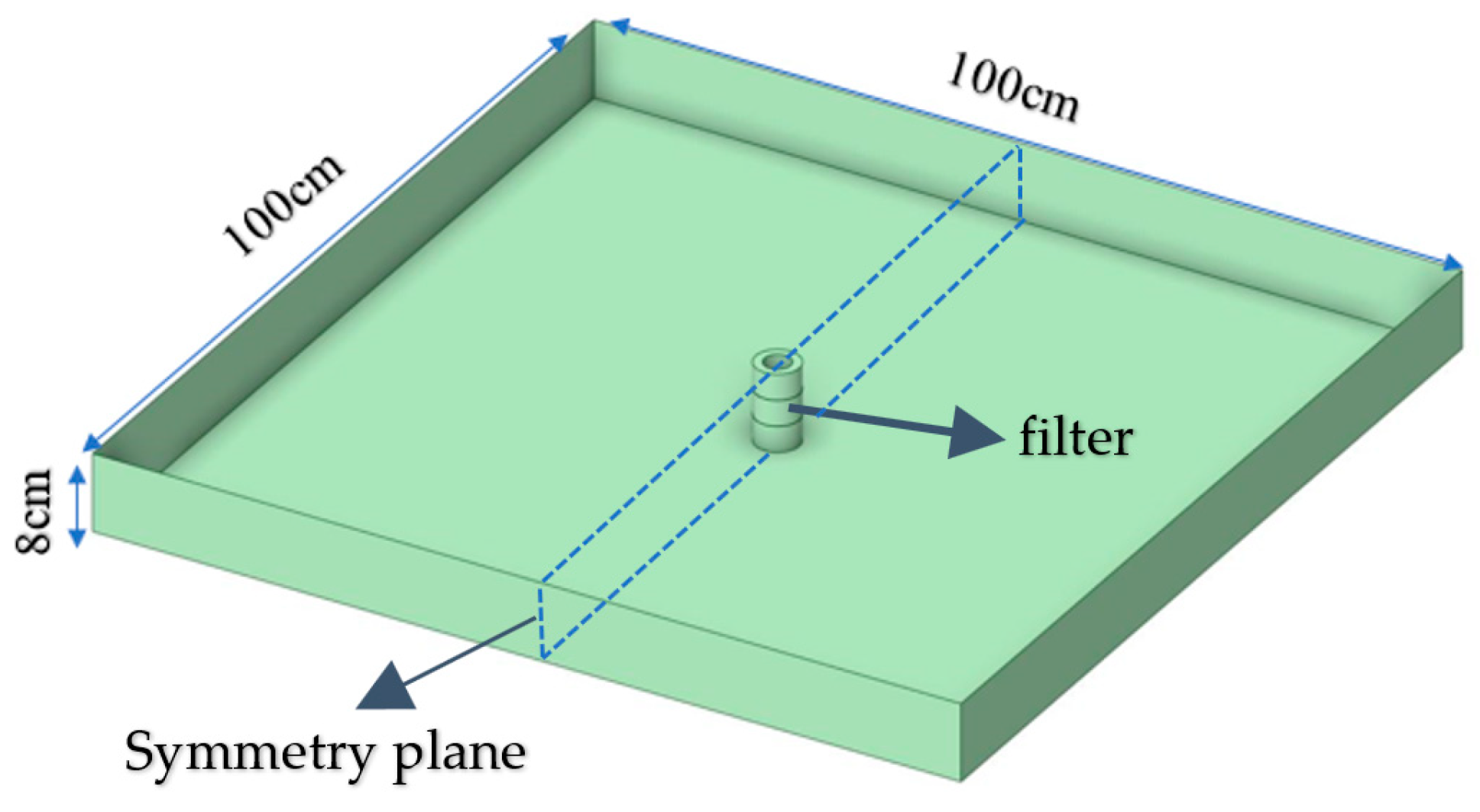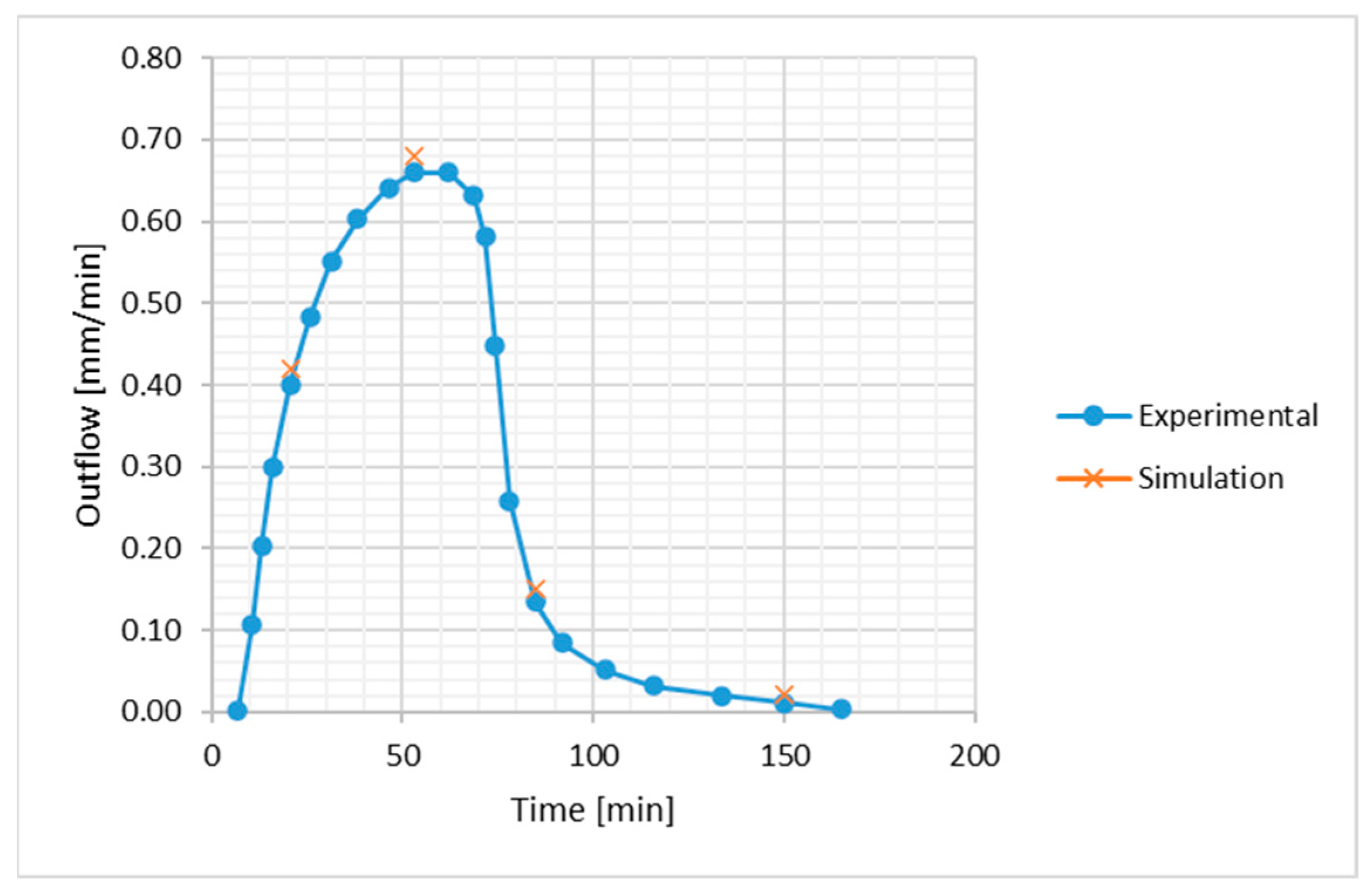Computational Fluid Dynamics Analysis of an Innovative Multi-Purpose Green Roof †
Abstract
:1. Introduction
2. Methodology
Model Setup
3. Results
4. Conclusions
Author Contributions
Funding
Institutional Review Board Statement
Informed Consent Statement
Data Availability Statement
Acknowledgments
Conflicts of Interest
References
- Loiola, C.; Mary, W.; Pimentel da Silva, L. Hydrological performance of modular-tray green roof systems for increasing the resilience of mega-cities to climate change. J. Hydrol. 2019, 573, 1057–1066. [Google Scholar] [CrossRef]
- Almeida, R.; Simões, N.; Tadeu, A.; Palha, P.; Almeida, J. Thermal behaviour of a green roof containing insulation cork board. An experimental characterization using a bioclimatic chamber. Build. Environ. 2019, 160, 106179. [Google Scholar] [CrossRef]
- Pirouz, B.; Palermo, S.A.; Becciu, G.; Sanfilippo, U.; Nejad, H.J.; Piro, P.; Turco, M. A Novel Multipurpose Self-Irrigated Green Roof with Innovative Drainage Layer. Hydrology 2023, 10, 57. [Google Scholar] [CrossRef]
- Zhu, S.; Causone, F.; Gao, N.; Ye, Y.; Jin, X.; Zhou, X.; Shi, X. Numerical simulation to assess the impact of urban green infrastructure on building energy use: A review. Build. Environ. 2023, 228, 109832. [Google Scholar] [CrossRef]
- Soulis, K.X.; Valiantzas, J.D.; Ntoulas, N.; Kargas, G.; Nektarios, P.A. Simulation of green roof runoff under different substrate depths and vegetation covers by coupling a simple conceptual and a physically based hydrological model. J. Environ. Manag. 2017, 200, 434–445. [Google Scholar] [CrossRef] [PubMed]
- Pettersson, K.; Maggiolo, D.; Sasic, S.; Johansson, P.; Sasic-Kalagasidis, A. On the impact of porous media microstructure on rainfall infiltration of thin homogeneous green roof growth substrates. J. Hydrol. 2020, 582, 124286. [Google Scholar] [CrossRef]
- Ahn, J.; Yeom, S.; Park, S.; Nguyen, T.H.T. Evaluation of infiltration rainwater drainage (Ird) system with fully 3-d numerical simulation approach. Appl. Sci. 2021, 11, 9144. [Google Scholar] [CrossRef]
- Elrahmani, A.; Al-Raoush, R.I.; Abugazia, H.; Seers, T. Pore-scale simulation of fine particles migration in porous media using coupled CFD-DEM. Powder Technol. 2022, 398, 117130. [Google Scholar] [CrossRef]
- VULCAFLOR. [Online]. Available online: https://www.europomice.it/en/products/vulcaflor/ (accessed on 3 April 2024).






| Name | Boundary Condition |
|---|---|
| Inlet | Mass-flow inlet |
| Outlet | Pressure outlet |
| Wall | No-slip |
| Soil | Porous zone 1 |
| Filter | Porous zone 2 |
Disclaimer/Publisher’s Note: The statements, opinions and data contained in all publications are solely those of the individual author(s) and contributor(s) and not of MDPI and/or the editor(s). MDPI and/or the editor(s) disclaim responsibility for any injury to people or property resulting from any ideas, methods, instructions or products referred to in the content. |
© 2024 by the authors. Licensee MDPI, Basel, Switzerland. This article is an open access article distributed under the terms and conditions of the Creative Commons Attribution (CC BY) license (https://creativecommons.org/licenses/by/4.0/).
Share and Cite
Naghib, S.N.; Pirouz, B.; Nejad, H.J.; Turco, M.; Palermo, S.A.; Piro, P. Computational Fluid Dynamics Analysis of an Innovative Multi-Purpose Green Roof. Eng. Proc. 2024, 69, 133. https://doi.org/10.3390/engproc2024069133
Naghib SN, Pirouz B, Nejad HJ, Turco M, Palermo SA, Piro P. Computational Fluid Dynamics Analysis of an Innovative Multi-Purpose Green Roof. Engineering Proceedings. 2024; 69(1):133. https://doi.org/10.3390/engproc2024069133
Chicago/Turabian StyleNaghib, Seyed Navid, Behrouz Pirouz, Hana Javadi Nejad, Michele Turco, Stefania Anna Palermo, and Patrizia Piro. 2024. "Computational Fluid Dynamics Analysis of an Innovative Multi-Purpose Green Roof" Engineering Proceedings 69, no. 1: 133. https://doi.org/10.3390/engproc2024069133
APA StyleNaghib, S. N., Pirouz, B., Nejad, H. J., Turco, M., Palermo, S. A., & Piro, P. (2024). Computational Fluid Dynamics Analysis of an Innovative Multi-Purpose Green Roof. Engineering Proceedings, 69(1), 133. https://doi.org/10.3390/engproc2024069133











